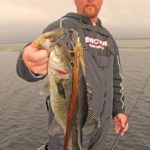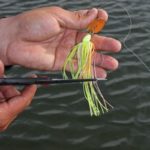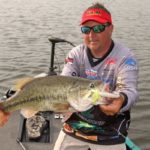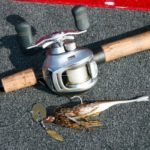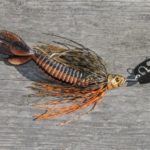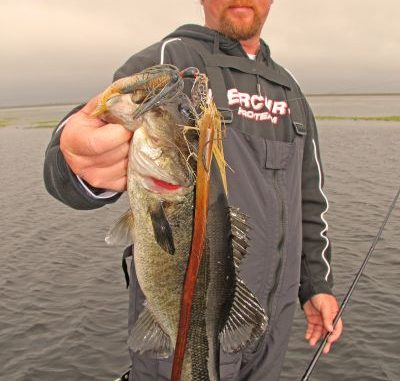
Vibe jigs deliver the shimmy that calls big bass out of their hiding places. Here’s all you need to know to get the most out of these lures.
This is not subtle. It’s not finesse. But it’s one of bass fishing’s bolder, attention-craving baits.
And it’s one of the more effective offerings for waters with diminished clarity.
We’re talking vibe jigs — often generically referred to by the commercial name “chatterbait,” similar to “Coke” for all colas or Jell-O for gelatins.
Essentially, it’s a swim jig fitted with a vibration-producing blade that does a fine job of plowing through the water and letting anything with a lateral line know it’s a comin’. And, although bass are mostly sight feeders, when they can hear and feel approaching prey they’re more apt to look for it.
From a full-sized ½-ounce model to the diminutive Z-Man Frog, the chatterbait offers an excellent search tool for target-rich environments ranging from stump fields to vast stands of submergent and emergent vegetation. Truly a versatile bait, it’s also effective for targeting specific structures like docks, laydowns, stumps and anything that might shelter a largemouth.
Toledo Bend guide Stephen Johnston likes running his V&M Lightning Blade around isolated patches of emergent grass, reeds, pad stems and pepper grass cover. And FLW Tour pro J.T. Kenney’s kind of partial to hydrilla.
“Most of the time, I’m fishing a chatterbait around sparse, shallow grass,” Kenney said. “You can fish it around deeper grass, but the shallow grass is where it really shines.”
An interesting note is how the chatterbait’s coast-to-coast applicability gives rise to lessons of broad geographic relevance.
Case in point: I covered a tournament on the California Delta — a tidal environment with lots of hydrilla-choked arteries very similar to a lot of Southeastern Louisiana’s bass fisheries — and the guy who won, Jim Moulton, noted that his a brown/orange Revenge vibe jig tempted fish with a crawfish color.
But the way he was able to fish it really maximized a scenario that others were simply under-utilizing.
“Everybody was just driving through that grass (punching), and I just backed off and targeted the channels in the grass that all the guys were driving over,” Moulton said.
Another point relevant to Louisiana’s tidal bass waters involves tide levels.
“When the tide was up, I could reach farther back into the grass beds,” Moulton said. “As the tide dropped, I could see those holes and lanes better.
“Bass will sit on the edges of these (openings) and watch for prey to move out with the tide.”
Junk in the trunk
Some chatterbaits come prepackaged with slender twin tails, but don’t hesitate to get creative for the purpose of imparting more action with various appendage-flapping creature baits.
Decisions often hinge on habitat, as sparse cover provides a wiggly trailer more room to perform than does heavier vegetation.
Swim baits offer a popular option for searching broad areas. Options include the Reaction Innovations Skinny Dibber, Yum Lil Suzee, Gambler, Big EZ and Strike King Swimming Caffeine Shad.
These swimming bodies not only enhance a chatterbait’s profile, but they also provide “lift” to keep the bait higher in the water at lower speed.
Kenney suggested matching trailer size to the realistic expectation of your area’s bass size. Big fish might eat a smaller profile bait, but forcing a larger trailer on smaller fish typically results in missed strikes.
Habitat also factors in, and Kenney uses trailer size to help keep his chatterbait running at the right depth.
“If I want the bait to ride high in the water — for example, over shallow grass — I’ll use a big trailer,” he explained. “And if I want the bait down lower in the water column — open areas, deeper water — I’ll use a smaller, slimmer trailer.”
For some models, like the Lightning Blade and the Strike King Pure Poison bladed swim jig, elongated skirt strands extending past the main skirt give the appearance of a trailer, but with less bulk.
Johnston said he’ll run that full skirt when the fish are aggressive, but if the bite’s tough or if he’s getting a lot of short-strikes or bumps he’ll trim that latter section to shorten the package.
And adding a plastic trailer instantly converts a shortened bait back to a longer profile.
Tweaks and accents
Jim Moulton offered a nifty trick for effective trailer rigging.
Typically, anglers thread the hook through the plastic body and bring the hook out so the trailer covers the hook shank with the bend exposed. Problem here is that short-strikers often pull the bait down and require you to reset the trailer.
Moulton “double hooks” his trailer by using the same basic form as you would with a Texas-rigged bait: He inserts the hook into the trailer’s head, brings it out about ¼-inch down the head, pulls the hook through, turns the hook and reinserts it into the body so the trailer aligns evenly with the hook.
Steve Chaconas guides bass trips on the Potomac River, where offshore hydrilla beds look just like the ones flourishing throughout a lot of Louisiana lakes, and he makes his own chatter-style baits and includes a small under-spin blade.
“When I first attached the small willow leaf with a swivel below the blade, I thought it would spin and add flash,” Chaconas said. “But, it didn’t work. While adding flash, the blade didn’t swim, it swung back and forth, coming in contact with the chatter blade. This caused a random and sudden veering off course of the Chatterwacky. This sudden movement triggered strikes.
“To get the bait to track again, I had to snap the bait to center it, which also generated strikes. What started as an effort to make a bait with a spinning willow blade turned into a mistake that catches fish.”
Tackle tip
Kenney said when the fish are really active that a stout rod and braided line serve well to dislodge a fish that’ll surely bury up in the veg after biting.
However, there are times when the bite is less aggressive and the standard tackle might work against you.
Most of the time, a motivated bass bites hard and hooks itself. But, say a weather system has the fish in a pouty mood, or maybe heavy fishing pressure has taken the edge off their bravado. Or, in a tidal environment, perhaps slack water finds them just halfheartedly swatting at passing baits.
In such scenarios, Kenney makes a key rod adjustment that allows the chatterbait’s single hook sufficient opportunity to do its thing.
“When they’re not really eating it, I’ll go to a cranking rod with fluorocarbon line,” Kenney said. “That softer tip lets those fish get a hold of that bait without pulling it away from them.
“It’s the same principle as a crankbait: The rod lets them load up on it.”
